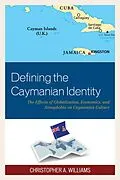Defining the Caymanian Identity analyzes the factions and schisms surging throughout the multicultural, multi-ethnic, and polarized Cayman Islands to identify who or what is considered a Caymanian. In the modern world where Caymanian traditions have all but been eclipsed, or forgotten, often due to incoming, overpowering cultural sensibilities, it is a challenge to know where traditional Caymanian culture begins and modern Caymanian culture ends. With this idea in mind, Christopher A. Williams investigates the pervasive effects of globalization, multiculturalism, economics, and xenophobia on an authentic, if dying, indigenous Caymanian culture. This book introduces and expounds the provocative solution that the continued prosperity of the Cayman Islands and their so-called indigenous people may well depend on a synergistic moral link between Caymanianness and foreignness, between Caymanianness and modernity.
Autorentext
Christopher Williams is assistant professor of history, English, and philosophy at the University College of the Cayman Islands.
Zusammenfassung
Defining the Caymanian Identity analyzes the factions and schisms surging throughout the multicultural, multi-ethnic, and polarized Cayman Islands to identify who or what is considered a Caymanian. In the modern world where Caymanian traditions have all but been eclipsed, or forgotten, often due to incoming, overpowering cultural sensibilities, it is a challenge to know where traditional Caymanian culture begins and modern Caymanian culture ends. With this idea in mind, Christopher A. Williams investigates the pervasive effects of globalization, multiculturalism, economics, and xenophobia on an authentic, if dying, indigenous Caymanian culture. This book introduces and expounds the provocative solution that the continued prosperity of the Cayman Islands and their so-called indigenous people may well depend on a synergistic moral link between Caymanianness and foreignness, between Caymanianness and modernity.
Inhalt
Chapter One: Becoming Native Caymanian
Chapter Two: The More Things Change: The Stubborn Decline of Racialism During Immediate Post-Emancipation
Chapter Three: And Then There was Light: The Shaping Conditions of a Distinct National-Cultural Caymanian Identity and its Subsequent Traditionalisms
Chapter Four: Bringing Traditionalist Ideas and Conceptions to Bear on a Cultural Caymanian Identity Beset by Material Hardship
Chapter Five: The Sustenance of Caymanian Identity in Geographical Displacement: A Case Study Approach
Chapter Six: Outgrowing the Surrogate Mother: Accounting for the Dramatic Shift in Caymanian Perceptions toward Jamaica and Jamaicans During the Federation Era
Chapter Seven: Proliferating Caymanianness: Accounting for the Factors that Lead to Division within Caymanian Nationality
Chapter Eight: Theory in Practice: Bringing the Legitimacy of Carnival and the Carnivalesque to Bear on Fractured Rhetorical Caymanian Culture
Conclusion: Why Can't We All Just Get Along?
